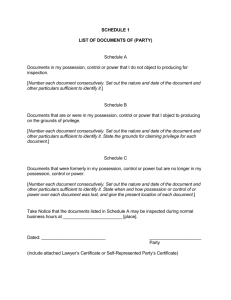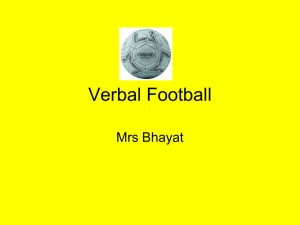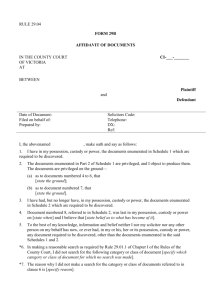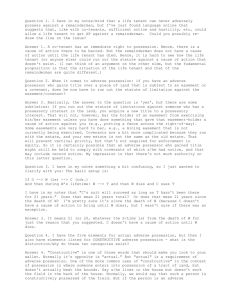Mamon Hamutal Bisafek
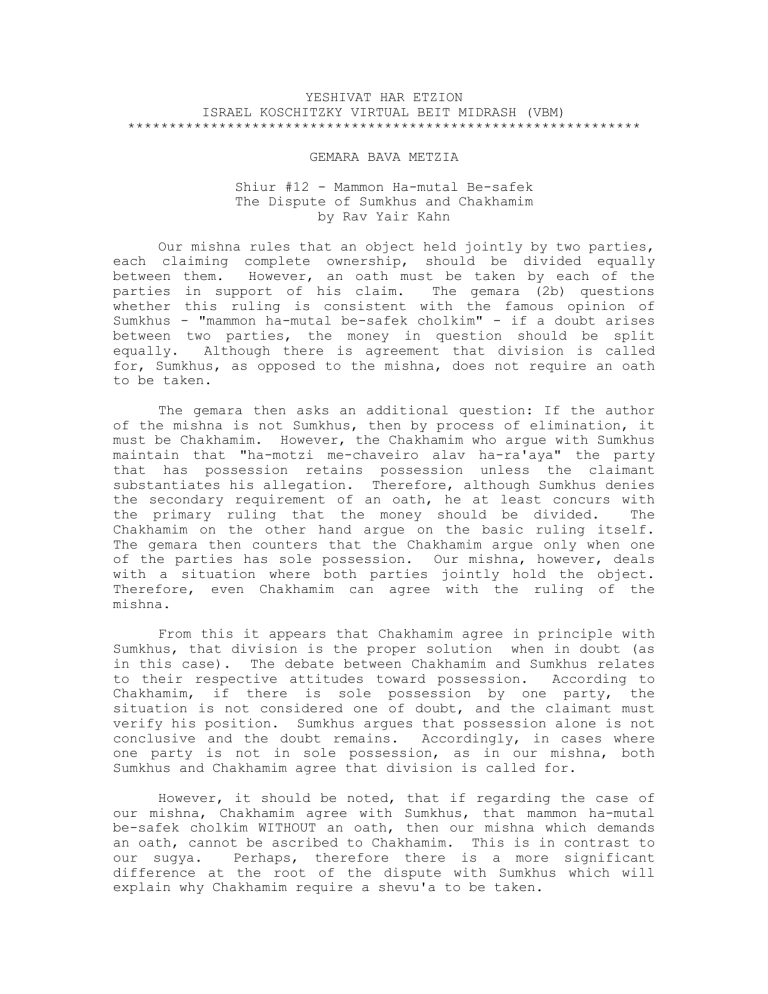
YESHIVAT HAR ETZION
ISRAEL KOSCHITZKY VIRTUAL BEIT MIDRASH (VBM)
**************************************************************
GEMARA BAVA METZIA
Shiur #12 - Mammon Ha-mutal Be-safek
The Dispute of Sumkhus and Chakhamim by Rav Yair Kahn
Our mishna rules that an object held jointly by two parties, each claiming complete ownership, should be divided equally between them. However, an oath must be taken by each of the parties in support of his claim. The gemara (2b) questions whether this ruling is consistent with the famous opinion of
Sumkhus - "mammon ha-mutal be-safek cholkim" - if a doubt arises between two parties, the money in question should be split equally. Although there is agreement that division is called for, Sumkhus, as opposed to the mishna, does not require an oath to be taken.
The gemara then asks an additional question: If the author of the mishna is not Sumkhus, then by process of elimination, it must be Chakhamim. However, the Chakhamim who argue with Sumkhus maintain that "ha-motzi me-chaveiro alav ha-ra'aya" the party that has possession retains possession unless the claimant substantiates his allegation. Therefore, although Sumkhus denies the secondary requirement of an oath, he at least concurs with the primary ruling that the money should be divided. The
Chakhamim on the other hand argue on the basic ruling itself.
The gemara then counters that the Chakhamim argue only when one of the parties has sole possession. Our mishna, however, deals with a situation where both parties jointly hold the object.
Therefore, even Chakhamim can agree with the ruling of the mishna.
From this it appears that Chakhamim agree in principle with
Sumkhus, that division is the proper solution when in doubt (as in this case). The debate between Chakhamim and Sumkhus relates to their respective attitudes toward possession. According to
Chakhamim, if there is sole possession by one party, the situation is not considered one of doubt, and the claimant must verify his position. Sumkhus argues that possession alone is not conclusive and the doubt remains. Accordingly, in cases where one party is not in sole possession, as in our mishna, both
Sumkhus and Chakhamim agree that division is called for.
However, it should be noted, that if regarding the case of our mishna, Chakhamim agree with Sumkhus, that mammon ha-mutal be-safek cholkim WITHOUT an oath, then our mishna which demands an oath, cannot be ascribed to Chakhamim. This is in contrast to our sugya. Perhaps, therefore there is a more significant difference at the root of the dispute with Sumkhus which will explain why Chakhamim require a shevu'a to be taken.
Returning to our gemara, the discussion mentioned above is puzzling. How could the gemara initially contemplate that "hamotzi me-chaveiro" applies in the case of our mishna where no one actually has sole possession? If neither of the parties is in possession, the other party can not possibly be "motzi mechaveiro" - attempting to remove from another's possession. The
Rashba is troubled by this, and explains that the gemara initially defines the case of the mishna where both jointly hold the object, as if each based on partial possession is assumed owner of HALF. Therefore, each must verify his claim if he wishes to be granted ownership over the second half. In the absence of such evidence, neither is believed, and is left with the half initially in his possession. This, the gemara claims would NOT require an oath, since the situation remains as it was.
The gemara concludes, however, that since both are holding on to the object, NEITHER is assumed as owner. Therefore, when the object is split, and each receives something which previously was not his, an oath is required. [Compare this the Rashba's comment later (3a s.v. ha de-amar) regarding whether to consider the oath mentioned in our mishna a "nishba ve-notel" or "nishba veniftar."]
In the ensuing section, the gemara quotes conflicting opinions whether Sumkhus applies his ruling only where the parties involved were themselves unsure of what transpired (shema ve-shema), or whether it is even applied when the parties submit definitive and, consequently, contradictory claims (bari u-bari).
If the position of Sumkhus were based on a rejection of the significance of possession, the nature of the claims would be irrelevant. Whether or not the parties are certain, the object should be divided equally among them since in either case a doubt exists in the eyes of beit din.
Moreover, it is ridiculous to assume that Sumkhus totally rejects the significance of possession. Is it reasonable that he would demand equal division any time one person claims that an object in another's possession is actually his? Clearly, such unsubstantiated claims would be rejected even according to
Sumkhus. (See daf 6a.)
Tosafot (100a s.v. Ha) quote the opinion of R. Shmuel, that
Sumkhus basically agree that possession IS significant. Based on their version of the gemara (100a), they conclude that Sumkhus argues with Chakhamim only when the object in question is not in the possession of either party. Chakhamim rule that the object remains the property of the original owner. Sumkhus, on the other hand, maintains that the object should be divided. In other words, the debate with Sumkhus revolves around the significance of "chezkat mara kama" - the assumption that the object belongs to the original owner. Sumkhus distinguishes between current possession (muchzak) and previous ownership
(chezkat mara kama).
Perhaps we can explain that being muchzak is more significant than standard chazakot which identify certain trends which help resolve doubts if and when they arise. Being muchzak defines the possessor as the owner, unless proven otherwise.
Therefore, both Sumkhus and Chakhamim agree that if one person is considered to be the owner based upon possession, an unbased counter claim cannot undermine this assumption. Hence, the object is not categorized as mammon ha-mutal be-safek, since no doubt has been cast regarding the ownership of the object.
Instead we apply the ruling of ha-motzi me-chaveiro alav hara'aya. When no one is in possession, and there is no established owner, both Sumkhus and Chakhamim concur that the object should be divided equally since it is a case of mammon hamutal be-safek.
The debate of Sumkhus and Chakhamim revolves around the significance of chezkat mara kama. According to Sumkhus, this chazaka, like others, identifies trends, but does not resolve our doubt. Therefore, in spite of this chazaka, the object remains in the shadow of doubt - mammon ha-mutal be-safek - and is divided. However, Chakhamim maintain that in the absence of possession, chezkat mara kama establishes a state of assumed ownership, which is not shaken by an unsupported allegation.
Hence, they rule ha-motzi me-chaveiro alav ha-ra'aya.
Apparently, Sumkhus and Chakhamim argue regarding the criterion needed to establish a state of assumed ownership.
Sumkhus is more demanding and requires actual possession which is a situation that expresses ownership, in order to confer the assumed status of owner. According to him, chezkat mara kama is awarded no more significance than a standard chazaka de-me'ikara
(assumed continuation of previously known status) which merely defines trends. Chakhamim, on the other hand, argue that based upon chezkat mara kama, we can extend the status of owner from the past to the present. (See Kuntras Hasefekot klal 8 siman 7).
Similarly, according to Tosafot, Chakhamim award the status of owner to a muchzak even if he cannot back up his possession with a concrete claim. Nevertheless, since he has possession of the object he is assumed to be the owner, and ha-motzi mechaveiro applies. Sumkhus argues since he maintains that the status of owner is conferred only in a situation which expresses ownership. Technical possession, in the absence of a claim, does not express ownership, and is no more than a standard chazaka which notes the status quo, but does not establish ownership.
Therefore, Sumkhus would define this case as mammon ha-mutal besafek.
According to this approach, we can explain the opinion that limits Sumkhus to a case of shema ve-shema, when the parties are themselves unsure. We questioned this based upon our initial assumption that Sumkhus totally rejects the significance of possession. According to R. Shmuel in Tosafot, Sumkhus agrees that possession is significant, but only when it expresses
ownership. Therefore, if the muchzak is bari, his possession expresses ownership and ha-motzi me-chaveiro applies. Only if the muchzak cannot forward a concrete claim (shema), then his possession is only technical, and does not express ownership, and it is a case of mammon ha-mutal be-safek.
However, it is clear that not all Rishonim accept this approach. Tosafot in Bava Kama (35b s.v. Zot) question how
Sumkhus could possibly consider that a mere claim is effective against possession. According to the approach developed above, there is no room for this question, since Sumkhus agrees to the clause ha-motzi me-chaveiro alav ha-ra'aya. Apparently, Tosafot in Bava Kama maintain that Sumkhus opts for division even where one side is in complete possession.
Tosafot in Bava Kama answer that Sumkhus' ruling is limited to cases where there is an objective basis for doubt (derara demammona). However, if no such basis exists, and one would claim an object in another's possession, even Sumkhus would not be receptive to his claim. On the other hand, in a case of derara de-mammona, Sumkhus would rule division even against a bona fide muchzak. Let us try to understand what is accomplished by derara de-mammona.
Perhaps we can clarify this issue by introducing an additional Tosafot. In Bava Metzia 97b, Tosafot (s.v. Leima) claim that according to Sumkhus we view both litigants as being in joint possession. This position is counter intuitive. We would certainly have preferred claiming that according to Sumkhus neither party is in possession. Why should we grant the status of muchzak to the empty-handed claimant?
Apparently, there is a distinction between two types of doubts. When there is no objective basis, the problem in its entirety is a function of contradictory claims, one of which is clearly dishonest. The court may be unsure which party to trust, but their doubt can be classified as "either-or" - who is telling the truth and who his lying. There is legitimacy to only one possibility, the question is - WHICH.
In contrast, derara de-mammona describes a case in which the situation itself generates doubt. Take for instance the mishna in Bava Kama (46a): "An ox gored a cow and a newborn calf was found lying dead alongside the cow, it is unknown whether the cow gave birth after or prior to being attacked." A cloud of uncertainty hovers over the entire case. The situation lends itself to two conceivable scenarios. Perhaps in such cases, we don't view the doubt negatively - not knowing which possibility to choose, but positively - granting legitimacy to both options.
We are not faced with an "either or" dilemma, but with two equally viable (though practically mutually exclusive) options.
According to this approach, derara de-mammona acts as a positive force granting power to both options. It defines the
case as mammon ha-mutal be-safek - an object thrust into an objective cloud of uncertainty. Therefore, it is feasible to consider both parties as being muchzak due to the derara demammona. Hence, the litigants can divide equally, even though only one has actual possession.
Based upon this approach, we can explain the problem of applying Sumkhus to a case of bari u-bari. In this case, in addition to the situation which is open equally to both scenarios, we are also faced with contradictory claims. Are we to ignore the claims, and grant both possibilities legitimacy based on the objective nature of the uncertainty. Or perhaps the contradictory allegations outweigh the objective doubt, and force us to reject one of the two clashing claims.
If we maintain our second approach, Sumkhus is working with a totally different concept them that of Chakhamim. Chakhamim arbitrate cases of doubt based on possession. Where one party is in total possession, the object will not be removed. Where both or neither are muchzak, then some type of compromise (division, kol de-alim gevar, yehei munach) is applied. Therefore, the gemara explains that our mishna which requires an oath to allow the court to split the object, is consistent with Chakhamim.
However, Sumkhus views division not as a compromise, but as a natural outgrowth of the state of derara de-mammona. Hence the demand of an oath to enable division is out of place.
Using this approach, we can also explain the difficulty in the sugya that we noted at the beginning of the shiur. How could the gemara have contemplated that ha-motzi me-chaveiro is applicable to our mishna? Isn't it obvious that there is no one party who is muchzak? However, if we interpret Chakhamim as totally rejecting the concept of mammon ha-mutal be-safek, this rejection applies even when there is no muchzak. Chakhamim reject division as an outgrowth of a state of objective safek, therefore there may be no basis for division in the case of our mishna. The gemara concludes that since neither party is muchzak, division is possible on grounds other than mammon hamutal be-safek. Dividing the object in question may be accepted by Chakhamim as a compromise since neither side is muchzak.
Summary
We developed two approaches regarding ruling of Sumkhus mammon ha-mutal be-safek cholkim. According to the first, both
Sumkhus and Chakhamim agree that mammon ha-mutal be-safek doesn't apply when one of the parties is defined as muchzak, since the rule of ha-motzi me-chaveiro alav ha-ra'aya outweighs mammon hamutal be-safek. The debate between Sumkhus and Chakhamim revolves around when the status of muchzak is applied.
According to the second approach, Sumkhus' halakha applies to a unique category classified as mammon ha-mutal be-safek.
This category is limited to situations where there is an
objective state of safek which grants legitimacy to both options.
According to Sumkhus this category overrides muchzak by granting equal status to both litigants. Chakhamim, on their part reject the entire category, and therefore apply ha-motzi me-chaveiro universally.
Sources and Questions for next week's shiur:
Sources:
1. 3a "Leima matnitin ... mi-ba'al ha-bayit," mishna 37a
"shnayim she-hifkidu ...."
2. 3a Tosafot s.v Ela.
3. Rashi 2a s.v. Be-mekach u-mimkar, Tosafot 2a s.v. Veyachloku, Tosafot 2b s.v. I tana.
4. Ramban 2a "ve-yesh omrim ... lav de-mar," Tosafot Bava Batra
34b s.v. Hahu "u-leRiva nireh ..."
Questions:
1. Do R. Yossi and Rabanan agree on principle, or do they have radically different understandings of "yihyeh munach?"
2. If each of the litigants holding on to the talit claims: "I wove it," what is the halakha? According to Rashi? According to
Tosafot? According to the opinion quoted in the Ramban?
3. Is the gemara on 3a more compatible with the opinion of Rashi or Tosafot?



